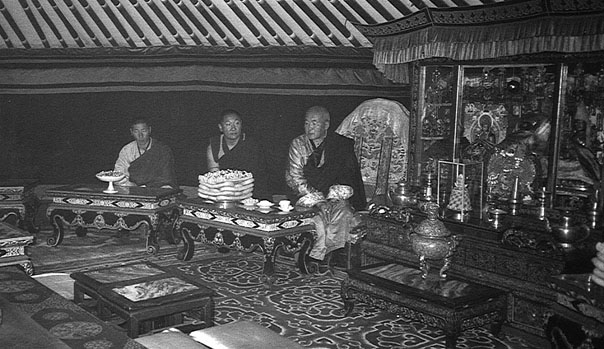| This Web book is based on public domain material provided by the US government and is available in several versions. See the editorial for more information. |

|

Home  The Society and Its Environment The Society and Its Environment  Religion Religion  Buddhism Buddhism |
||||||
| See also: The Suppression of Buddhism, Uses of Buddhism, Traditional Patterns, Religious Survivals, Historical Traditions, The End of Independence | ||||||






|
||||||
Buddhism
Traditional Mongols worshipped heaven (the "clear blue sky") and their ancestors, and they followed ancient northern Asian practices of shamanism, in which human intermediaries went into trance and spoke to and for some of the numberless infinities of spirits responsible for human luck or misfortune. In 1578 Altan Khan, a Mongol military leader with ambitions to unite the Mongols and to emulate the career of Chinggis, invited the head of the rising Yellow Sect of Tibetan Buddhism to a summit. They formed an alliance that gave Altan legitimacy and religious sanction for his imperial pretensions and that provided the Buddhist sect with protection and patronage. Altan gave the Tibetan leader the title of Dalai Lama (Ocean Lama), which his successors still hold. Altan died soon after, but in the next century the Yellow Sect spread throughout Mongolia, aided in part by the efforts of contending Mongol aristocrats to win religious sanction and mass support for their ultimately unsuccessful efforts to unite all Mongols in a single state. Monasteries were built across Mongolia, often sited at the juncture of trade and migration routes or at summer pastures, where large numbers of herders would congregate for shamanistic rituals and sacrifices. Buddhist monks carried out a protracted struggle with the indigenous shamans and succeeded, to some extent, in taking over their functions and fees as healers and diviners, and in pushing the shamans to the religious and cultural fringes of Mongolian culture.
In Tibet Buddhism thus became an amalgam, combining colorful popular ceremonies and curing rituals for the masses with the study of esoteric doctrine for the monastic elite. The Yellow Sect, in contrast to competing sects, stressed monastic discipline and the use of logic and formal debates as aids to enlightenment. The basic Buddhist tenet of reincarnation was combined with the Tantric idea that buddhahood could be achieved within a person's lifetime to produce a category of leaders who were considered to have achieved buddhahood and to be the reincarnations of previous leaders. These leaders, referred to as incarnate or living buddhas, held secular power and supervised a body of ordinary monks, or lamas (from a Tibetan title bla-ma, meaning "the revered one)". The monks were supported by the laity, who thereby gained merit and who received from the monks instructions in the rudiments of the faith and monastic services in healing, divination, and funerals. Buddhism and the Buddhist monkhood always have played significant political roles in Central and Southeast Asia, and the Buddhist church in Mongolia was no exception. Church and state supported each other, and the doctrine of reincarnation made it possible for the reincarnations of living buddhas to be discovered conveniently in the families of powerful Mongol nobles.
Tibetan Buddhism is monastic. By the beginning of the twentieth century, Outer Mongolia had 583 monasteries and temple complexes, which controlled an estimated 20 percent of the country's wealth. Almost all Mongolian cities have grown up on the sites of monasteries. Yihe Huree, as Ulaanbaatar was then known, was the seat of the preeminent living buddha of Mongolia (the Jebtsundamba Khutuktu, also known as the Bogdo Gegen and later as Bogdo Khan), who ranked third in the ecclesiastical hierarchy, after the Dalai Lama and the Panchen Lama. Two monasteries there contained approximately 13,000 and 7,000 monks, and the prerevolutionary Mongol name of the settlement known to outsiders as Urga, Yihe Huree, means big monastery. Over the centuries, the monasteries acquired riches and secular dependents; they gradually increased their wealth and power as those of the Mongol nobility declined. Some nobles donated a portion of their dependent families - people, rather than land, were the foundation of wealth and power in old Mongolia - to the monasteries; some herders dedicated themselves and their families to serve the monasteries either from piety or from the desire to escape the arbitrary exactions of the nobility. In some areas, the monasteries and their living buddhas (of whom there were a total of 140 in 1924) also were the secular authorities. In the 1920s, there were about 110,000 monks, including children, who made up about one-third of the male population, although many of these lived outside the monasteries and did not observe their vows. About 250,000 people, more than a third of the total population, either lived in territories administered by monasteries and living buddhas or were hereditary dependents of the monasteries. With the end of Chinese rule in 1911, the Buddhist church and its clergy provided the only political structure available, and the autonomous state thus took the form of a weakly centralized theocracy, headed by the Jebtsundamba khutuktu in Yihe Huree. By the twentieth century, Buddhism had penetrated deeply into Mongolian culture, and the populace willingly supported the lamas and the monasteries. Foreign observers had a uniformly negative opinion of Mongolian monks, condemning them as lazy, ignorant, corrupt, and debauched, but the Mongolian people did not concur. Ordinary Mongolians apparently combined a cynical and realistic anticlericalism, sensitive to the faults and the human fallibility of individual monks or groups of monks, with a deep and unwavering concern for the transcendent values of the church.
|
||||||
Home  The Society and Its Environment The Society and Its Environment  Religion Religion  Buddhism Buddhism |
||||||
Last Update: 2010-12-07



